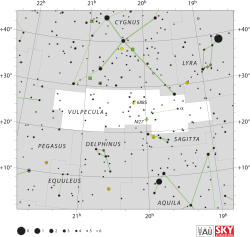BW Vulpeculae
| BW vulpeculae | |
 | |
| Observationsdata Epok: J2000.0 | |
|---|---|
| Stjärnbild | Räven |
| Rektascension | 20t 54m 22,39491s[1] |
| Deklination | +28° 31′ 19,1827″[1] |
| Skenbar magnitud () | 6,54 ± 0,01[2] (6,44 - 6,68)[3] |
| Stjärntyp | |
| Spektraltyp | B2 IIIv[4] |
| U–B | -0,147 ± 0,011[5] |
| Variabeltyp | Beta Cephei-variabel[6] |
| Astrometri | |
| Radialhastighet () | -6,1 ± 3,0[7] km/s |
| Egenrörelse (µ) | RA: +0,437[1] mas/år Dek.: -4,981[1] mas/år |
| Parallax () | 1,1494 ± 0,0652[1] |
| Avstånd | 2 800 ± 200 lå (870 ± 50 pc) |
| Absolut magnitud () | -2,47[8] |
| Detaljer | |
| Massa | 6,8 ± 0,1[9] eller 11 - 14[10] M☉ |
| Luminositet | 515,14[5] L☉ |
| Temperatur | 23 014 +919−883[11] K |
| Metallicitet | +0,07 ± 0,12[11] |
| Vinkelhastighet | 24 ± 6[2] km/s |
| Ålder | 3,4 ± 2,5[9] miljarder år |
| Andra beteckningar | |
| HD 199140, AG+28 2353, ALS 14834, BD+27 3909, GSC 02183-02731, HIC 103191, HIP 103191, HR 8007, IRAS 20522+2819, 2MASS J20542238+2831192, PPM 112113, SAO 89265, TD1 27433, TYC 2183-2731-1, uvby98 100199140, BW Vulpeculae, WISEA J205422.40+283119.0, WISE J205422.39+283119.1, Gaia DR3 1845911110565337472, Gaia DR2 1845911110565337472[12][13] | |
BW Vulpeculae eller HD 199140, är ensam stjärna belägen i den norra delen av stjärnbilden Räven. Den har en genomsnittlig skenbar magnitud av ca 6,54[2] och är mycket svagt synlig för blotta ögat där ljusföroreningar ej förekommer. Baserat på parallax enligt Gaia Data Release 2 på ca 1,15 mas,[1] beräknas den befinna sig på ett avstånd på ca 2 800 ljusår (870 parsek) från solen. Den rör sig närmare solen med en heliocentrisk radialhastighet på ca -6 km/s.[7]
Egenskaper
[redigera | redigera wikitext]BW Vulpeculae är en blå jättestjärna av spektralklass B2 IIIv,[4] där suffix v anger variation i dess spektrala egemskaper. Den har en massa som är ca 6,8[9] solmassor, men andra författare har enspridning på 10-14 solmassor.[10] Den utsänder från dess fotosfär energi motsvarande 515[5] gånger solen vid en effektiv temperatur av ca 23 000 K.[7]

Variabiliteten hos BW Vulpeculae tillkännagavs 1937 av den kanadensiska astronomen Robert Methven Petrie, vid American Astronomical Societys 58:e möte.[15] Den är en Beta Cephei-variabel med variation mellan magnituderna 6,44 och 6,68 med en period av 4,8 timmar.[3] Av okänd anledning har stjärnans periodicitet genomgått plötsliga förändringar, följt av långa perioder av stabilitet.[16] BW Vulpeculae är en av de mest extrema Beta Cephei-stjärnorna när det gäller variation av ljusstyrka och radiell hastighet.[2][17] Detta antas bero på stjärnans relativt höga metallicitet, vilket betyder överskott av andra element än väte och helium.[10] Ett utmärkande särdrag för dess cykel av radiell hastighet är en unik "stillestånds"-funktion, som orsakas av en stötvåg som genereras av infall av material från en tidigare cykel.[17]
Referenser
[redigera | redigera wikitext]- Den här artikeln är helt eller delvis baserad på material från engelskspråkiga Wikipedia, BW Vulpeculae, 14 augusti 2023.
Noter
[redigera | redigera wikitext]- ^ [a b c d e f] Brown, A. G. A.; et al. (Gaia collaboration) (August 2018). "Gaia Data Release 2: Summary of the contents and survey properties". Astronomy & Astrophysics. 616. A1. arXiv:1804.09365. Bibcode:2018A&A...616A...1G. doi:10.1051/0004-6361/201833051.
- ^ [a b c d] Stankov, A.; et al. (September 2003). "Abundances and radial velocity analysis of BW Vulpeculae". Astronomy and Astrophysics. 408 (3): 1077–1086. Bibcode:2003A&A...408.1077S. doi:10.1051/0004-6361:20031005.
- ^ [a b] Otero, Sebastian Alberto (21 November 2011). "BW Vulpeculae". AAVSO Website. American Association of Variable Star Observers. Hämtad 2 augusti 2015.
- ^ [a b] Lynds, C. R. (September 1959). "The light-variability of early B giants". Astrophysical Journal. 130: 577. Bibcode:1959ApJ...130..577L. doi:10.1086/146747.
- ^ [a b c] Anderson, E.; Francis, Ch. (2012). "XHIP: An extended hipparcos compilation". Astronomy Letters. 38 (5): 331. arXiv:1108.4971. Bibcode:2012AstL...38..331A. doi:10.1134/S1063773712050015. S2CID 119257644.
- ^ Samus', N. N; Kazarovets, E. V; Durlevich, O. V; Kireeva, N. N; Pastukhova, E. N (2017). "General catalogue of variable stars: Version GCVS 5.1". Astronomy Reports. 61 (1): 80. Bibcode:2017ARep...61...80S. doi:10.1134/S1063772917010085. S2CID 125853869.
- ^ [a b c] Gontcharov, G. A. (November 2006). "Pulkovo Compilation of Radial Velocities for 35 495 Hipparcos stars in a common system". Astronomy Letters. 32 (11): 759–771. arXiv:1606.08053. Bibcode:2006AstL...32..759G. doi:10.1134/S1063773706110065. S2CID 119231169.
- ^ Gontcharov, G. A. (November 2012). "Spatial distribution and kinematics of OB stars". Astronomy Letters. 38 (11): 694–706. arXiv:1606.09028. Bibcode:2012AstL...38..694G. doi:10.1134/S1063773712110035. S2CID 119108982.
- ^ [a b c] Tetzlaff, N.; et al. (January 2011). "A catalogue of young runaway Hipparcos stars within 3 kpc from the Sun". Monthly Notices of the Royal Astronomical Society. 410 (1): 190–200. arXiv:1007.4883. Bibcode:2011MNRAS.410..190T. doi:10.1111/j.1365-2966.2010.17434.x. S2CID 118629873.
- ^ [a b c] Fokin, A.; et al. (November 2004). "Hydrodynamic models for β Cephei variables. I. BW Vulpeculae revisited". Astronomy and Astrophysics. 426 (2): 687–693. Bibcode:2004A&A...426..687F. doi:10.1051/0004-6361:20040418.
- ^ [a b] Niemczura, E.; Daszyńska-Daszkiewicz, J. (April 2005). "Metallicities of the β Cephei stars from low-resolution ultraviolet spectra". Astronomy and Astrophysics. 433 (2): 659–669. arXiv:astro-ph/0410440. Bibcode:2005A&A...433..659N. doi:10.1051/0004-6361:20040396. S2CID 14295631.. Note: value taken from [m/H].
- ^ BW Vul (unistra.fr). Hämtad 2024-02-11.
- ^ "BW Vul". SIMBAD. Centre de données astronomiques de Strasbourg. Hämtad 7 september 2018.
- ^ "MAST: Barbara A. Mikulski Archive for Space Telescopes". Space Telescope Science Institute. Hämtad 8 december 2021.
- ^ Petrie, R. M. (1939). "A new Beta Canis Majoris-type star". Publications of the American Astronomical Society. 9: 53. Bibcode:1939PAAS....9Q..53P.
- ^ Odell, A. P. (August 2012). "Period variation in BW Vulpeculae redux". Astronomy & Astrophysics. 544: 4. arXiv:1205.5996. Bibcode:2012A&A...544A..28O. doi:10.1051/0004-6361/201219418. S2CID 119279687. A28.
- ^ [a b] Smith, Myron A.; et al. (December 2005). "Far-Ultraviolet and Optical Observations of BW Vulpeculae". The Astrophysical Journal. 634 (2): 1300–1310. Bibcode:2005ApJ...634.1300S. doi:10.1086/497026.





